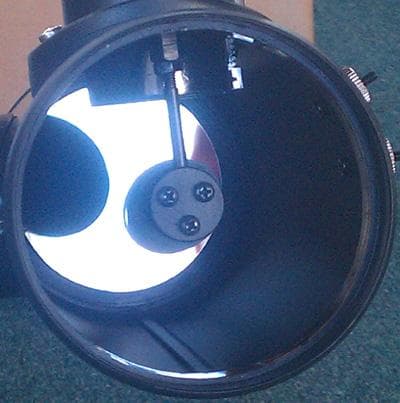
with David Fuller

Orion Funscope 76 review (Part 2)
I cannot believe what I just saw in this little 76mm Funscope from Orion. Literally, it is jaw-dropping. (Click here for Part 1 of this review.)
Okay, it probably helps that it is a ridiculously transparent night tonight. I can see 4th magnitude stars while I have 8 (count them, EIGHT) outdoor lights streaming into my front yard where I did the observing. Now granted, I started with the easy stuff. The Pleiades, M45, is a naked-eye object, so it's not like that target is particularly difficult to see anyway.
But I saw 4 dozen stars in it. Using a stupid little 76mm refractor, and a 20mm 3-element eyepiece. Is that supposed to happen? Perhaps.
So I turned towards another easy object: Collinder 70, the "S" shaped pattern of stars in Orion's belt. Again, not hard. Bright stars, can be seen in a set of binoculars. Were all the stars perfect pinpoints? Well.... no. In fact, when I pointed towards Polaris to do a star-test, the collimation of this scope is off. And it appears to be a primary mirror collimation issue, but I'll look at it more closely tomorrow when I have a chance. But even so, I can see a lot of stars in this little set of optics. And not just stars, but more.
I turned towards M42. Again, easy and bright, right? Well... yes. I can spot this one in binoculars, and even see color in a 70mm refractor, so this is not surprising to spot simply. And there are more that I could see - and should see, since they are technically "binocular visible" objects anyway:
The Double Cluster
The Alpha Persei Cluster
M34, M35, M36, M37, M38, M41, M44
Okay, so what Dave, right? Alright, how about these:
M81 and M82.
That's right - the elliptical and edge-on galaxies in Ursa Major. But it wasn't even so much that I could see them. Okay, I take that back - it WAS that fact that I could see them, but it was also how quickly and easily I found them. Yes, I know where I'm looking. I just pointed in about a 10 degree distance from Phad through Dubhe and then did a little "spiral" and "Bingo!" - there they were. The reason I could do that so easily though, is because of how wide a field of view this thing has.
Using the 20mm eyepiece, I could easily fit all three belt stars of Orion, and still have room to spare. If I'd been using a typical 60 or 70 mm refractor? Not so much. The view would be, at best, probably half that, if not less. That means scanning-and-panning with this scope is just easy to do. And when you're "in the neighborhood" of the object you're trying to see, you're also more likely to see it, because just a little "spiraling" around in the area, and brighter objects are easy to spot. Want to see more? Bump up the magnification.
But maybe you've even seen M81 and M82 in binoculars, and saying, "So what, Dave?" I can go one better.
M1. The Crab Nebula.
Now seeing this one says to me it most definitely IS a very transparent night tonight. Normally I'm good if I see this in a 90mm refractor or larger. So to spot it at all in this small an instrument means I have good viewing conditions, and you can't always expect to see M1 in this, depending on your local light pollution and the sky on any given night.
But I saw M1 in a 76mm telescope.
I don't live in "dark sky" country. Yes, I live in "better than Chicago" conditions. The area surrounding my town is not more civilization, but corn and soybean fields for 5 miles in every direction. On the flip side, there are three car dealerships in my town - and at this time of night, ALL of those lights are on. Plus, we don't have "dark sky friendly" lights here. They are all of the "bad" cobra head style streetlights, and almost every garage, porch and post lamp spews light in every which direction.
And that's why I am amazed at this little scope. No, the collimation is not spot-on right out of the box. In fact, Jupiter didn't look all that great, despite the fact that I could see 4 pinpoint moons. And the out-of-focus view of Polaris tells me the collimation is off. But for $60 new? Seriously, how can you go wrong with this?
A kid can use this, easily. Point, focus, see. Simple! Would it do better at higher magnification? Yes, if the focal length were longer, but then it would lose it's "wide field" benefits. I haven't looked at the Moon yet with this one, but I know what it looked like in my Celestron FirstScope. You can see craters - there's enough jaw-dropping "WOW!" for those who are new to astronomy. What you will NOT see is jaw-dropping "WOW!" of Mars, Jupiter or Saturn - the three other "good" objects to see in the solar system. If you want to look at those, consider something else.
As a "pick it up and observe in 10 seconds out the door" telescope, it's hard to go wrong with this. If you spend $60 to get a kid hooked on astronomy with this, it's worth that investment. Just be warned: This scope is not a "be-all, end-all" scope. So once it has outlived the "whet the appetite" phase, be prepared to spend more on a bigger, better scope when the views through this one are exhausted.
I did try it as an "equatorial style" with the tripod tilted. Let's just say you'd need to use a really heavy duty tripod to do that effectively - that's not to say it's not possible. But it causes the tripod to be seriously unbalanced. With proper counterweighting, or a sufficiently well-built plywood stand on which to attach it, it could work that way okay, I suppose. But I wouldn't recommend it without some additions or modifications to standard tripod equipment.
Not sure about astronomy yet? My videos haven't convinced you to buy a $300 or $400 scope? Go inspire a kid - or yourself. Get this one - get your feet wet. It's worth the investment. Just know up front that you will likely wind up spending more, because it will make you want a bigger, better telescope in short order.
You have been warned. ;-)
